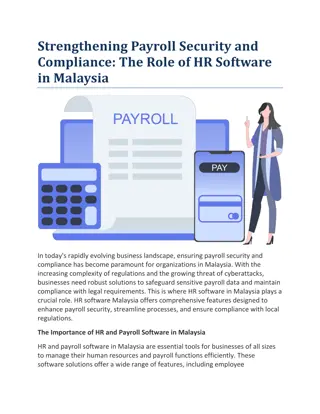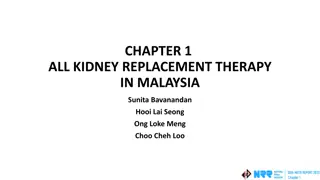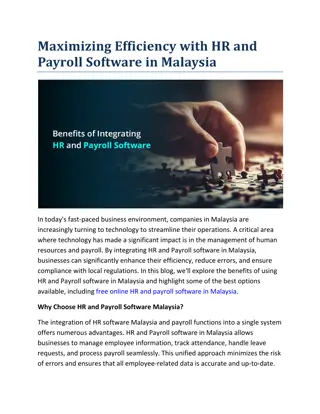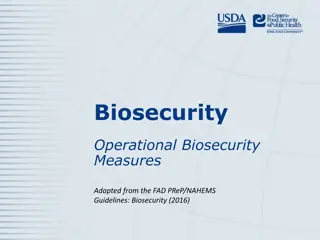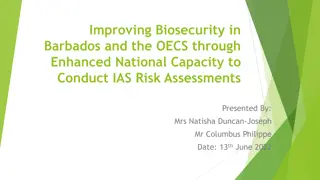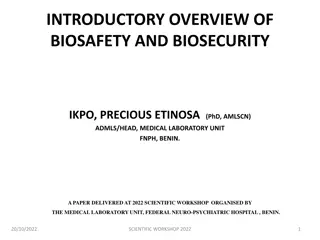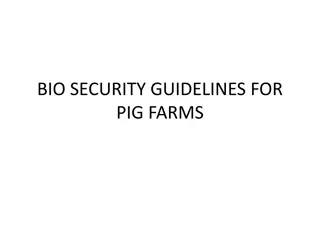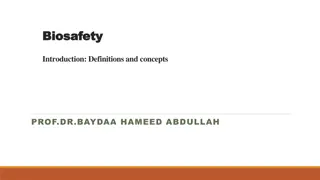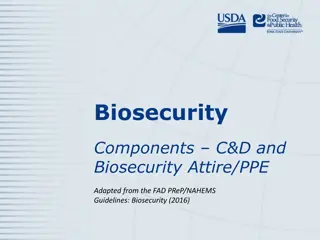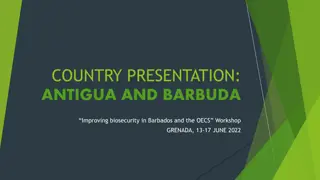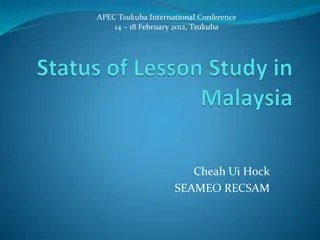Plant Biosecurity Division - Department of Agriculture, Malaysia
Plant Biosecurity Division under the Department of Agriculture in Malaysia is responsible for safeguarding the national agriculture industry from pests and diseases. Their functions include enforcing plant quarantine regulations, developing export protocols, reporting outbreak statuses, and participating in international plant protection activities to ensure biosecurity standards.
Download Presentation

Please find below an Image/Link to download the presentation.
The content on the website is provided AS IS for your information and personal use only. It may not be sold, licensed, or shared on other websites without obtaining consent from the author.If you encounter any issues during the download, it is possible that the publisher has removed the file from their server.
You are allowed to download the files provided on this website for personal or commercial use, subject to the condition that they are used lawfully. All files are the property of their respective owners.
The content on the website is provided AS IS for your information and personal use only. It may not be sold, licensed, or shared on other websites without obtaining consent from the author.
E N D
Presentation Transcript
ADDRESS & CONTACT DETAILS ADDRESS & CONTACT DETAILS Director Plant Biosecurity Division Department of Agriculture Wisma Tani, Jalan Sultan Salahuddin 50632 Kuala Lumpur, Malaysia Tel: +603-2030 1401 Fax: +603-2691 3530 Email: ngiza@doa.gov.my/mycontactpoint@doa.gov.my Website: http://www.doa.gov.my
ORGANISATION CHART ORGANISATION CHART Ministry of Agriculture and Agro-Based Industry Department of Agriculture Peninsular Malaysia Malaysia Quarantine Inspection Services (MAQIS) Peninsular Malaysia Agriculture Component Region 2 Agriculture Component Region 1 Department of Agriculture Sabah Department of Agriculture Sarawak All Entry Points Offices in Peninsular Malaysia Enforcement and Plant Protection Section Plant Protection and Quarantine Branch *Note - NPPO Plant Biosecurity Division (PBD) Pesticide Control and Fertilizer Division - Managing authorities to carry out the function of the NPPO - Pesticide Registration
FUNCTION FUNCTION To protect national agriculture industry from pests and diseases through enforcement of Plant Quarantine Act 1976, Plant Quarantine Regulations 1981, MAQIS Act 2011 and International Standards of Phytosanitary Measures (ISPMs)
FUNCTION FUNCTION To develop exportation protocol draft for horticultural produce to fulfil importing country s phytosanitary requirements To explore new market and obtain market access for horticultural produce through trade negotiation To develop, review and manage import requirements For plant, plant products and regulated articles to ensure the national plant biosecurity is protected
FUNCTION FUNCTION To report outbreak status of emerging pests and control measures that have been taken to International Plant Protection Convention (IPPC) To eradicate and control spread/outbreak of foreign plant pests and diseases that have entered the country To prevent entry and spread of endemic and exotic plant pests and diseases To participate in To implement standards and participate in activities under related international bodies such as Regional Plant Protection Organisation (RPPO), IPPC, WTO, STDF, APEC To participate in bilateral and multilateral meetings (e.g. ASEAN), seminars and Free Trade Agreement (FTA) negotiations under SPS chapter standards drafting and implement the standards adopted by Commission of Phytosanitary Measures (CPM) IPPC (International Standards of Phytosanitary Measures ISPMs)
FUNCTION FUNCTION To manage endemic plant pests and Invasive Alien Species (IAS) through forecast, surveillance, diagnostic and mitigation To issue Phytosanitary Certificate to ensure that export consignment is free from pests and diseases To manage accreditation schemes such as MPCA, MAFAS and MAHTAS and other certification to fulfil SPS requirements and international standards To enforce Convention on International Trade in Endangered Species of Wild Fauna and Flora (CITES) 2008 for flora species to control movement of national germplasms To manage National Collection and Plant Pest Repository To develop and adapt suitable technology, provide expert and diagnostic services and recommendation on pests and diseases control



